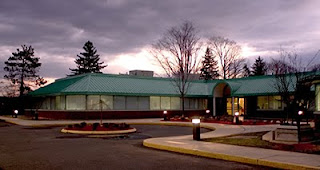From accident reconstruction to 'CSI' - The Citizens Police Academy

Watch out, bad guys. I am now trained in the use of Tasers, batons, pepper spray and handcuffs.
After 10 Tuesday-night classes at the Connecticut Police Academy in Meriden, I’ll never look at a tire track the same way again. I’ve learned about the history of the state police, the different aspects of the agency and what day-to-day life can be like for a state trooper.
I’ve gained a new respect for the physical requirements of the job – not only must a cadet in my age group (30-39) be able to do 25 sit-ups and 19 push-ups in a minute and run 1.5 miles in less than 16 minutes, but those who are accepted into the academy get tested regularly and exercise daily. (I lucked out since there were no physical requirements for the Citizens Academy).
State troopers must stay in shape, constantly learn new defense moves and practice handling their weapons often so they don’t get overtaken and have their weapons used against them. They must always be ready for the worst possible criminals – those who put up a fight.
“It’s almost impossible to control somebody who doesn’t want to be controlled,” said Trooper Matt Allen, a 13-year veteran with the state police.
Allen teaches Safety & Survival. He specializes in Taser instruction, is trained in motor vehicle law and is an instructor for Krav Maga, a hand-to-hand combat-martial arts style from Israel.
“Prison is just like a university for bad guys,” said Trooper Matt Allen, a 13-year veteran with the state police.
The criminals spend a lot of time working out, and then they get ideas from other inmates, he said. Therefore, officers must work just as hard to stay ahead.
I have a pretty good idea what it feels like traveling down I-91 south on a motorcycle at 170 mph after watching a recording from the view of a motorcyclist who eventually got decapitated when he clipped the back of a tractor trailer. He had been racing others and was quickly changing lanes during rush-hour traffic in the summer of 2008. His girlfriend on the back lost an arm but survived.
The state police traffic unit has investigated this and 449 other crashes with similarly gruesome results just in the past three years, according to Mark Pereira, an accident reconstructionist who has been with the state police for 10 years and before that worked as an electrical engineer.
Officers can determine the cause of a crash, who was driving what vehicle and at what speed, who was at fault and whether a mechanical failure may have caused the crash.
Using a tool that resembles a tire filled with cement, and a complex math formula, an officer can determine friction on the road.
“This job is very math intensive,” he said (and I mentally crossed it off my list as a possible new career).
Pereira also showed some gruesome accident photos – including rollovers – advocating for people to wear their seat belts.
“A seat belt greatly increases your chance of survival in a crash,” he said. “It greatly reduces your injuries.”
If you get ejected from a moving car, by laws of nature the car will “chase” you and you might end up getting crushed and killed by your own vehicle.
“It’s not like CSI,” Director Kenneth Zercie kept saying when we visited the Connecticut Forensic Science Laboratory in Meriden. “I wish we could solve two to three crimes in 45 minutes.”
But most things he was telling and showing us seemed exactly like “CSI.” Except, of course, for the part where every office was shut down at 6 p.m. because of “limited resources” – the lab cannot afford to keep people working 24/7 like forensic scientists do on the popular TV drama.
Test results are also produced a lot slower in reality (results of a nuclear DNA tests take 3-4 days, not a couple of hours), which is why the lab is about six years behind in its workload, not counting any new cases that might come in. The lab services the entire state – police, fire, FBI, CIA and any other regulatory agency in Connecticut that needs assistance. It also re-examines evidence for convicted felons who appeal their conviction.
“This is a very expensive operation,” Zercie said, although he added that some parts are paid for by federal grants. “This is the only lab in Connecticut that does what we do.”
Of course, big cases like the murder of Yale graduate student Annie Le end up taking up a big part of the lab’s time and end up costing hundreds of thousands of dollars.
“I wish we could do that on every case we get in here,” Zercie said. “Every case, if it was treated like that, would be solved.”
Instead, the dedicated, smart people who work in the lab (Ph.D. or six years of forensic experience required for entry-level position) lock up the evidence at night and go home.

But the real action is actually with the Eastern, Central and Western District Major Crime Squads. The crime squad detectives are the ones on the grisly murder scenes documenting, collecting and analyzing the evidence. Exactly like on “CSI.”
“That’s mainly what we do,” said Detective Chris Sudock from the Central District Major Crime Squad. “Although we’re not as pretty, and we don’t solve crimes as fast. But anything that anyone thinks is a ‘major crime’ – we investigate it.”
The characters on television also tend to do things “in the wrong order,” he said. On the show they do tire tracks, analyze, DNA, take photos - they are all over the place. At the state police, the crime investigators always process a scene the exact same way – documentation, evidence collection, specialized processing, autopsy. The evidence is always collected in the same manner, photos taken by two people, sketch maps made, evidence collected inch-by-inch and everything labeled and packaged properly. Afterward, extremely thorough reports are written.
“We are all very good writers,” Sudock said. “We write a report on each photo and why we took it.”
Sometimes they have to write about the lack of evidence gathered. But the key is always in the details. Suduck said his squad’s reports are so thorough that the cases they investigate very rarely go to trial.
“Defense attorneys have no place to attack,” he said.
The three major crimes units in the state handle requests from the FBI, the state’s attorney and local police departments. While the FBI has its own investigators, “they would rather use us,” Sudock said proudly. “But no individual unit will ever take credit for solving a crime.”
The crime squad has colorful, cheap yarn in its van’s bullet trajectory kit (“bullets always fly in straight lines”) as well as a microwave labeled “microwave” in a small kitchenette. The two refrigerators in the van – one for food and one for evidence – are not marked, however, making me wonder if anyone ever dares to store real food in there. The $350,000 van serves as a lab, a kitchen, a bedroom and a conference room. And this is where many crimes get solved, based on forensic evidence.
“Everything you touch, everywhere you go, you leave something behind,” said Zercie, at the crime lab. “But you also take something with you.”
So, remember that, if you’re ever going to commit a crime. You might get to meet a state police officer sooner than you’d expected.
RELATED: CLICK HERE FOR THE TOP 10 HISTORIC FACTS ABOUT THE STATE POLICE
 RSS
RSS




